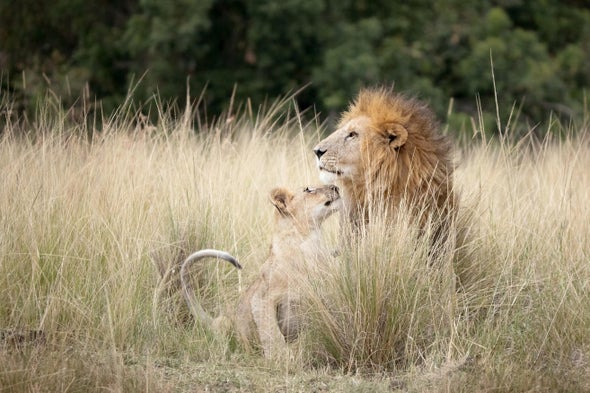Male lions face numerous challenges and dangers throughout their lives, from the moment they are born. Tragically, one in two male lions die within their first year, facing threats such as snakebites, hungry hyenas, and infanticide from other male lions. If they survive their first year, they become independent at around 3 years old and enter a period of nomadism, where their chance of survival drastically decreases. They form coalitions with other male lions, but their size and strength determine their survival and reproductive success. Despite these dangers, Kenya has a large lion population and is committed to conservation efforts. While male lions face immense obstacles, it is important to understand that lionesses also play a crucial role in population health and should be a focus for conservation efforts.
Challenges Faced by Male Lions
Male lions, the iconic kings of the savannah, face numerous challenges and dangers throughout their lives. From the moment they are born, male lion cubs must confront a world that is both hostile and unforgiving. In this article, we will explore the various challenges that male lions face, from high mortality rates within their first year to threats from predators, nomadism, competition for survival and reproduction, and vulnerability to human pressures.

High Mortality Rate within First Year
Male lion cubs have a precarious start in life, with one in two not surviving their first year. This staggering mortality rate is a result of several factors, from predation by other animals to snakebites and infections. With a lack of protective manes and smaller sizes compared to their adult counterparts, young male lions become easy targets for hungry predators.
Predation from Other Animals
One of the primary threats male lion cubs face is predation from other animals, particularly hyenas. These opportunistic scavengers often target vulnerable lion cubs, taking advantage of their relatively defenseless state. With their sharp teeth and pack mentality, hyenas can overpower and kill young male lions, further contributing to the high mortality rate within the first year.
Snakebites and Infections
Apart from predation, male lion cubs are also susceptible to snakebites and infections. As they explore their surroundings and venture beyond the safety of their pride, cubs can come into contact with venomous snakes and other hazards. Additionally, wounds sustained from fights with other males or accidental injuries can become infected, leading to severe health complications and ultimately, death.
Threats from Predators
Even after surviving their first year, male lions continue to face threats from predators. Hungry hyenas, in particular, pose a significant danger to mature male lions. These cunning and formidable predators are known to target weakened, injured, or solitary lions, making them vulnerable to fatal attacks.
Attacks from Hungry Hyenas
When food becomes scarce, hyenas become more desperate and aggressive. They will not hesitate to attack lions, both male and female, in an attempt to secure a meal for themselves and their pack. These attacks can result in severe injuries or even death for male lions unfortunate enough to cross paths with hungry hyenas.
Infanticide by Other Male Lions
In the harsh world of the lion pride, males must constantly defend their territory and reproductive rights. In some instances, this competition can turn violent and deadly. Male lions, including those who have recently become fathers, may engage in infanticide, killing cubs fathered by rival males in order to assert their dominance and increase their own chances of passing on their genes.
Nomadism and High Risk of Death
If a male lion successfully navigates the challenges of their first year, they will reach around 3 years of age, becoming independent and entering a period of nomadism. During this stage, male lions leave their birth pride and begin their search for a new territory. However, this nomadic lifestyle comes with a high risk of death and few male lions make it to the age of 10.
Independence at Around 3 Years Old
Around the age of three, male lions become sexually mature and are forced to leave their pride in search of their own territories. This independence is necessary to avoid inbreeding and competition with their own fathers. However, it also exposes them to various dangers and challenges as they venture into unfamiliar areas.
Few Male Lions Make it to Age 10
Despite their strength and resilience, male lions face numerous threats during their nomadic phase, resulting in a low survival rate. From territorial disputes with other males to starvation and encounters with aggressive predators, the harsh reality is that only a few male lions manage to survive past the age of 10 and establish their own prides.
Competition for Survival and Reproduction
One of the biggest challenges male lions face is competition for survival and reproduction. Male lions form coalitions with other males, and the size and strength of these alliances often determine their chances of survival as well as their reproductive success.
Formation of Coalitions
Male lions tend to form close-knit coalitions with their brothers or unrelated males from the same litter. These alliances provide strength in numbers and a united front to defend against rival male coalitions or predators. By joining forces, males can increase their chances of securing territory and mating opportunities.
Size and Strength of Coalitions
The success of a male lion coalition depends greatly on its size and strength. Larger coalitions have an advantage in territorial disputes, as they can overpower smaller groups or individual males. Moreover, a larger coalition can defend multiple females within a pride, increasing their chances of reproducing and passing on their genes.
Survival and Reproductive Success
With larger coalitions having a competitive edge, the survival and reproductive success of male lions are closely linked. Those who fail to form or maintain strong coalitions may find themselves at a significant disadvantage, facing diminished territory, limited access to mates, and increased vulnerability to attacks from rival males.
Fights with Rival Coalitions
The competition for survival and reproduction often leads to fierce battles between male lion coalitions. These fights can be brutal and even fatal, with males using their powerful jaws and claws to inflict serious wounds on their adversaries. It is these intense conflicts that ultimately determine which coalition will emerge victorious and claim dominance over specific territories.

Vulnerability to Human Pressures
Aside from natural challenges, male lions are also vulnerable to human pressures that threaten their existence. Poaching and killings by farmers to protect their livestock are two significant factors that contribute to the decline of lion populations.
Poaching
Poaching, driven by illegal wildlife trade, still remains a major threat to male lions. Their bones, skins, and other body parts are highly valued in certain cultures for traditional medicine or ornamentation. The illegal hunting and trafficking of lions for these purposes have devastating consequences for their populations, potentially leading to local extinctions if left unchecked.
Killings by Farmers to Protect Livestock
In regions where humans and wildlife coexist, conflicts often arise when lions attack livestock. Farmers, trying to protect their livelihoods, may resort to killing lions in retaliation. This lethal conflict not only endangers individual lions but also perpetuates a negative cycle of human-wildlife conflict that can further diminish lion populations.
Importance of Lionesses in Conservation
While male lions often attract attention due to their imposing presence, it is crucial not to overlook the vital role of lionesses in conservation efforts. Lionesses play a significant role in population health and must be a focus of conservation strategies.
Crucial Role in Population Health
Lionesses not only contribute to the maintenance of lion populations through reproduction but also play key roles in hunting and communal care for cubs. They are the primary providers of food for their pride, utilizing their agility and cooperative strategies to ensure successful hunts. Additionally, lionesses engage in nurturing behaviors that promote cub survival and social cohesion within the pride.
Conservation Efforts Should Focus on Lionesses
To ensure the long-term survival of lions, conservation efforts should prioritize the protection of lionesses. Initiatives should aim to secure and restore suitable habitats, enhance anti-poaching measures, and foster community-based conservation programs that address the root causes of human-wildlife conflict. By empowering and involving local communities, conservation efforts can create a sustainable future for lion populations.

Conservation Efforts in Kenya
Despite the many challenges faced by male lions, Kenya is home to a significant lion population and has shown a strong commitment to conservation efforts. The country has implemented various initiatives to protect lions and their habitats, recognizing the importance of these majestic animals to the local ecosystem and tourism industry.
Large Lion Population in Kenya
Kenya boasts one of the largest lion populations in Africa, with several national parks and reserves providing protected areas for these magnificent creatures. The Maasai Mara National Reserve, Amboseli National Park, and Meru National Park are just a few examples of the diverse habitats that support thriving lion populations in Kenya.
Commitment to Conservation Efforts
The Kenyan government, along with conservation organizations and local communities, has made significant strides towards lion conservation. Efforts include strengthening anti-poaching patrols, implementing community-led strategies for coexistence with wildlife, and supporting research projects focused on understanding and conserving lion populations.
In conclusion, male lions face numerous challenges throughout their lives. From the high mortality rates within their first year to the threats posed by predators, nomadism, competition for survival and reproduction, and vulnerability to human pressures, male lions navigate a world that constantly tests their strength and resilience. To protect these majestic animals and ensure their long-term survival, conservation efforts should not only focus on male lions but also recognize the crucial role that lionesses play in population health. With dedicated conservation initiatives, there is hope for the future of male lions, and Kenya stands as a shining example of a country committed to their protection.

